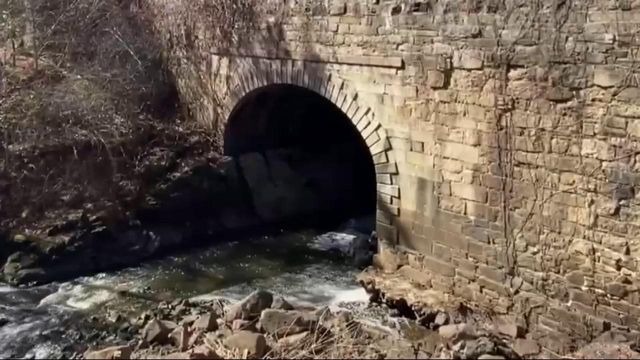Tunnels, jails and canals: Remnants of the Underground Railroad still exist in Halifax County
In this quiet rural community, you can touch tangible remnants of this painful and often-forgotten past.
Posted — UpdatedIn the 1700 and 1800s, major rivers were known as "Freedom Roads," and if you explore the Roanoke River in Halifax County, you'll find pieces of the Underground Railroad's history still standing today.
Halifax County is the only place in N.C. with three registered historic sites on the National Underground Railroad Network to Freedom. In this quiet rural community, you can touch tangible remnants of this painful and often-forgotten past.
There's a jail, nearly two centuries old, that once held captive fugitives who had attempted to escape slavery.
There's a trail that leads to the Roanoke River – and along the trail, historians have placed signs showing actual newspaper ads ran by plantation-owners seeking men and women who had escaped slavery.
There's even a 200-year-old stone aqueduct – imposing and draped in ivy in the middle of the woods – that was built using enslaved labor – then later used as part of the Underground Railroad itself.
Runaway ads: "Of a smiling countenance - has been very much whipped"
Along a trail to the Roanoke River, city councilwoman and historian Sandra Bryant says she can almost sense the Freedom Seekers who once walked in these very woods, following the river to a dream of freedom.
Today, the Underground Railroad Trail is just one place in Historic Halifax that allows visitors a glimpse of this history.
"We have put up newspaper ads showing what it was really like for enslaved peoples when they tried to seek freedom," says Bryant. "People need to know. They need to understand what it was really like."
One such ad, dating back to 1793, describes an enslaved man who had escaped, reading:
"To describe the man's smile, and in the same sentence explain he's been whipped on the back," says Bryant. "It's awful. It's important for people to really understand how it was."
Bryant says she dreams of adding even more to this trail, to help visitors really step back in time.
"I dream of adding little camps just off the trail in the woods, to show where Freedom Seekers would hide out during the day and wait until dark to move and follow the river."
A 200-year-old tunnel was once part of the canal system
The rapids along the Roanoke River made it an especially treacherous river for men and women escaping slavery to cross. However, those rapids also provided the opportunity for escape – in the form of a canal construction camp where slave labor was heavily used.
"Freedom seekers could hide among the enslaved men already in the camp," says Steven Green-Hockaday.
The enormous stone aqueduct, tunnel and culvert are tangible pieces of history built by enslaved men – men who seldom have their stories told or remembered in modern history books.
"You can touch it. You can put your hands where they put their hands," says Green-Hockaday.
The tunnel is part of the Roanoke Canal Trail, which runs along the remnants of the old canal itself – with earthen walls pushed up on either side of the modern day trail. Other ruins from its former life can be found in the woods, like remnants of the massive bulkhead for the "Power Canal," the old stone surge control, a riverside mill and the Roanoke Canal Museum.
The museum is housed in the old power house of the canal, and antique remnants of the canal's original locks can be seen here.
Roanoke's rapids: A small stretch of river was "known" as a site on the Underground Railroad
Halifax County has more sites considered part of the Underground Railroad than any other place in the state – and a lot of that has to do with a small stretch of river that made a huge impact.
"There was a 7-mile stretch of rapids that made it difficult for boats to pass, but those rapids provided the ideal opportunity for freedom seekers hoping to escape slavery," said Green-Hockaday. "Those rapids were why the aqueduct was built."
The Roanoke River was a main transport for getting goods and services to many different places – so it was a great way to escape, says Bryant.
"It was known through the Underground Network that once you got to Halifax you would find people who could help you. Provide you food, shelter, until you could get on a boat or escape down the river," she says.
She says the Town of Halifax was also known for having the highest free population of freed Black men and women during that time.
"Those that were still enslaved would come and blend in with the freedmen in the town," she says.
Frank McMahon, a historic interpreter for Historic Halifax, says, "Often these freedmen would be sympathetic towards freedom seekers, even helping hide them."
From Halifax, a person escaping slavery could try any number of tactics to get away down the river.
Black History Month: Visit tangible remnants of the Underground Railroad in NC
- Historic Halifax State Historic Site, 25 St. David St., Halifax. Visit the 1800s jail, walk the Underground Railroad trail to the Roanoke River, read the 'fugitive slave ads' along the trail, and visit many other historic houses.
- River Falls Park, 100 Rockfish Drive in Weldon, N.C. Enjoy sweeping views of the Roanoke River rapids.
- Roanoke Canal Museum and Trail, 15 Jackson Street, Roanoke Rapids. Explore the old aqueduct and other remnants along the canal trail. Walk through the museum to see in-depth history and stories of the Underground Railroad, and see the canal's old powerhouse and original locks.
• Credits
Copyright 2024 by Capitol Broadcasting Company. All rights reserved. This material may not be published, broadcast, rewritten or redistributed.






